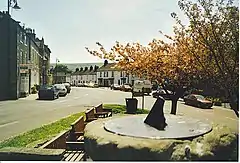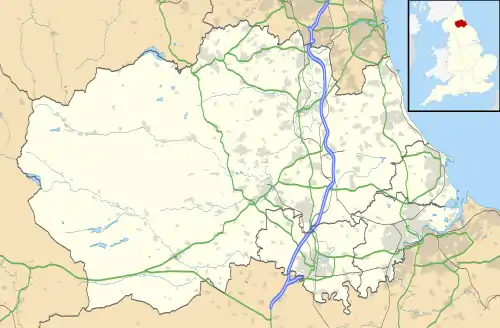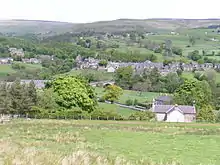Middleton-in-Teesdale
Middleton-in-Teesdale is a market town in County Durham, in England. It is situated on the north side of Teesdale between Eggleston and Newbiggin, a few miles to the north-west of Barnard Castle. The settlement is surrounded by the North Pennines Area of Outstanding Natural Beauty (AONB).
| Middleton-in-Teesdale | |
|---|---|
 Middleton-in-Teesdale town centre | |
 Middleton-in-Teesdale Location within County Durham | |
| Population | 1,137 (2011)[1] |
| Shire county | |
| Region | |
| Country | England |
| Sovereign state | United Kingdom |
| Post town | BARNARD CASTLE |
| Postcode district | DL12 |
| Police | Durham |
| Fire | County Durham and Darlington |
| Ambulance | North East |
| UK Parliament | |
Administration
Middleton is administered by Durham County Council. It is part of the Bishop Auckland parliamentary constituency in the House of Commons. Prior to Brexit in 2020, it was a part of the North East England constituency for the European Parliament. The local police force is Durham Constabulary.


History
The small market town in Upper Teesdale expanded in the early 19th century when the London Lead Company moved its northern headquarters there from Blanchland in Northumberland. Much of the architecture from its days as a company town is still clearly visible. This includes Middleton House, formerly the headquarters of the company, the school (which is now an outdoor centre) and some company houses.
St Mary's Church, rebuilt in the late 1870s, has a historic detached bell tower with bells dating back to the 16th century.[2] There are separate chapels for Catholics, Baptists, Wesleyans and Primitive Methodists.[3]
A fountain was erected in the town in 1877 to honour Robert Walton Bainbridge, superintendent of the London Lead Mining Company.[4]
Middleton served as the terminus of a railway line from Barnard Castle until this was closed as part of the Beeching Axe. The Wynch Bridge from 1830 close to the Low Force waterfall was built to allow miners to reach the Middleton mines.[5] It is thought to be one of the oldest suspension bridge in England.[6]
On 20 June 1939, a British American Air Services De Havilland Dragon Rapide (Registration:G-AERE) flying from Heston Aerodrome to Newcastle Airport crashed at Forest-in-Teesdale near Middleton-in-Teesdale. The weather was bad and the aircraft was flying low. The accident killed all three passengers and crew on board.[7]
References
- "Town population 2011". Retrieved 7 July 2015.
- "St Mary's Middleton-in-Teesdale". Upper Teesdale Churches Together. Retrieved 1 March 2020.
- "Middleton in Teesdale County Durham". Vision of Britain. Retrieved 1 March 2020.
- 'Memorial Fountain to be repaired' Teesdale Mercury 23.7.2014 page 16
- "Wynch Bridge". Britain Express. Retrieved 1 March 2020.
- Trevelyan, W.C. (1828). "Description of the winch bridge, the oldest suspension bridge in England". The Philosophical Magazine. Taylor & Francis: The Philosophical Magazine, Series 2, Vol 4. 4 (23): 386. doi:10.1080/14786442808674863.
- "G-AERE". Baaa-acro.com. Archived from the original on 23 September 2012. Retrieved 6 November 2011.
External links
| Wikimedia Commons has media related to Middleton-in-Teesdale. |